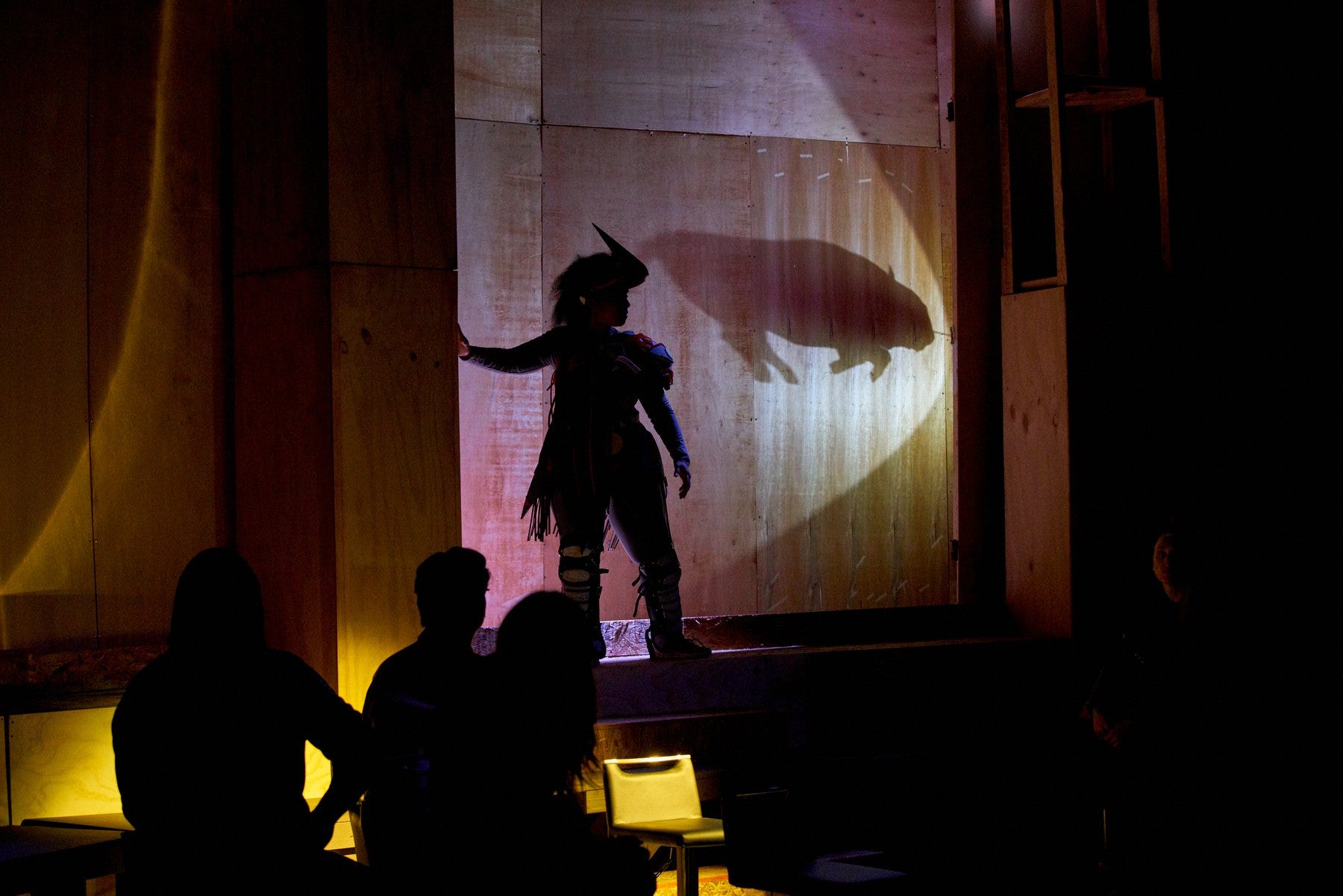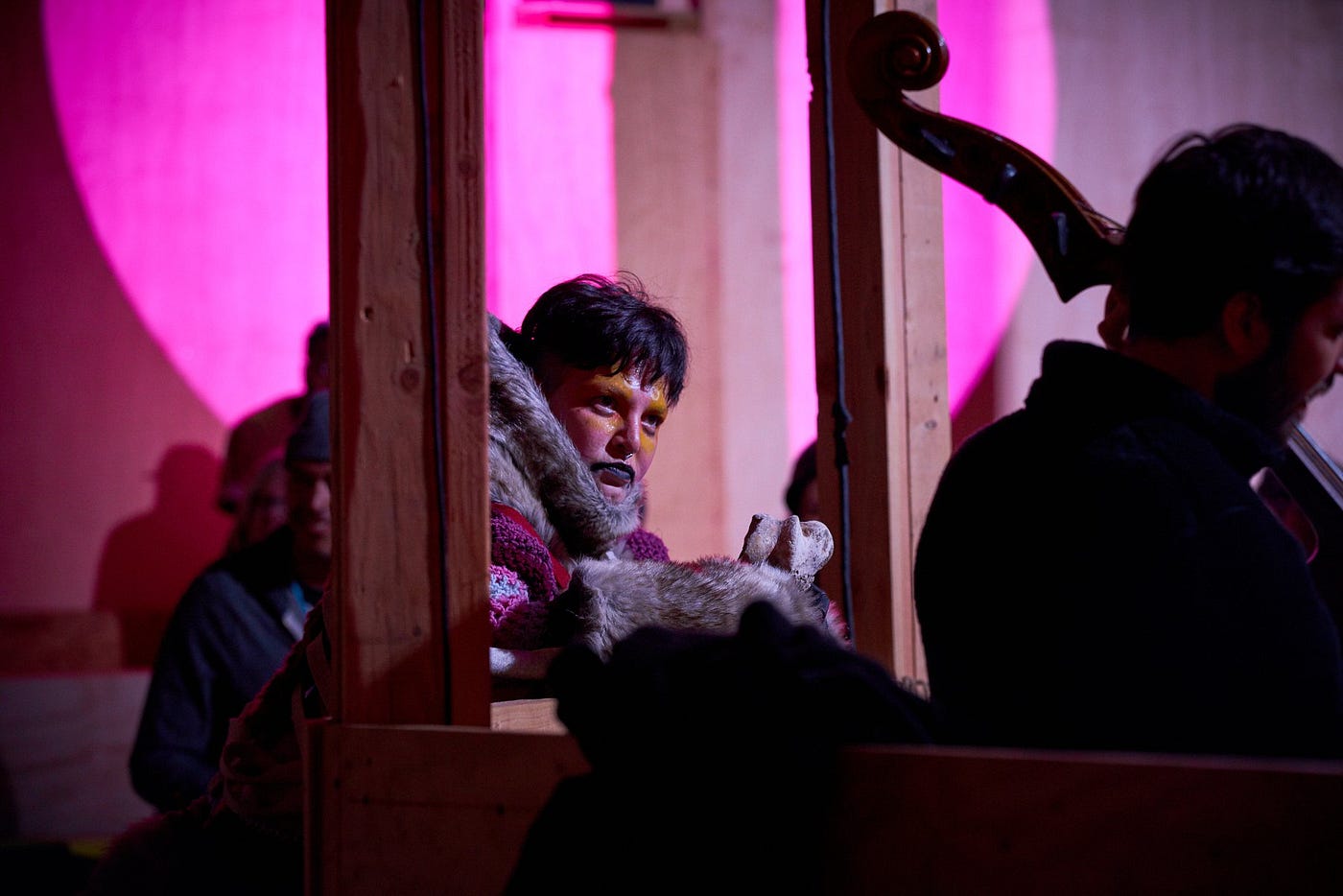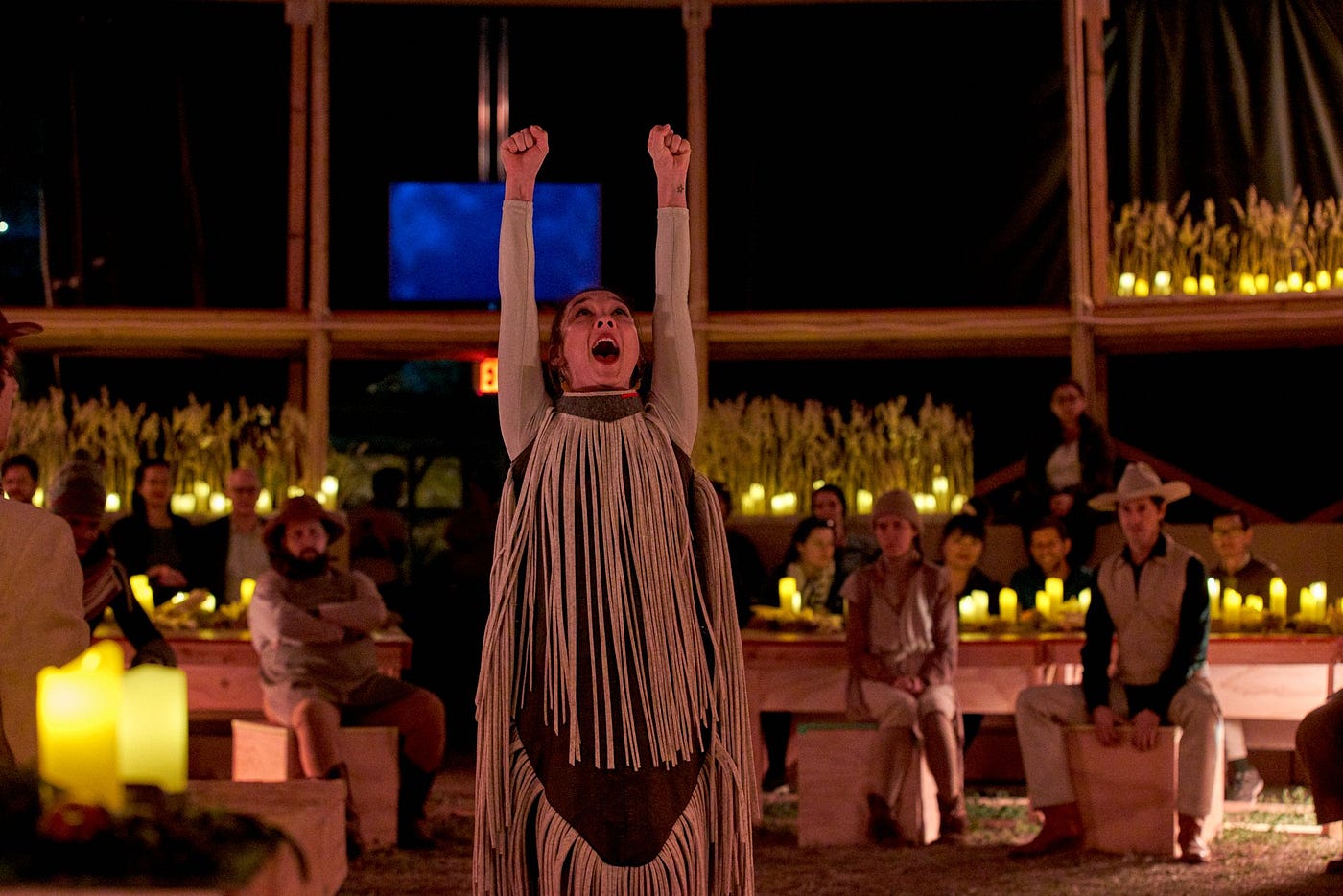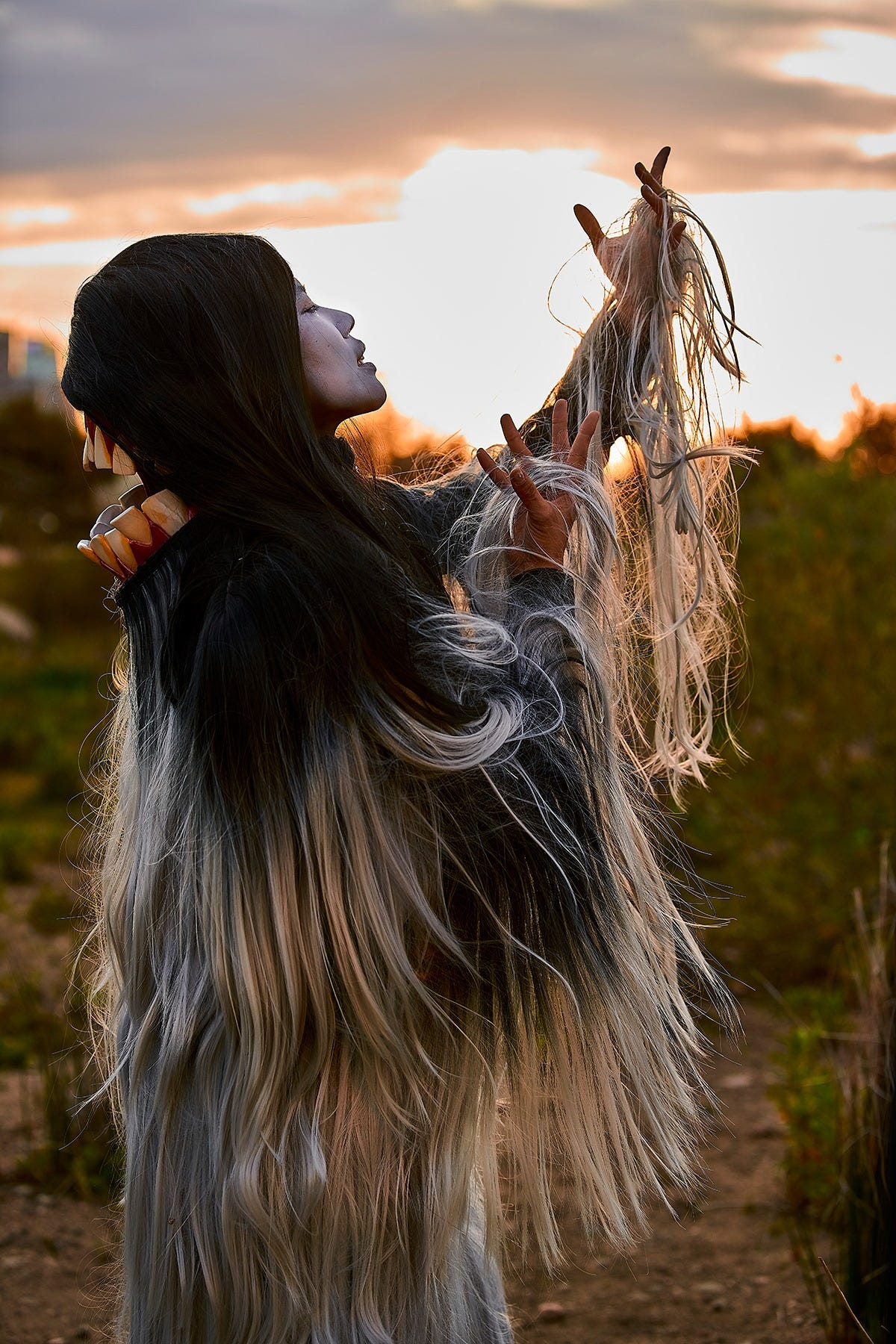The Industry Opera’s ‘Sweet Land’ Traverses Difficult Terrain (Review)
The iconic company’s site-specific, outdoor piece grapples with American history


Sweet Land is — like a lot of art which aims to provoke — about discomfort. This particular flavor of discomfort manifests itself in multiple places, from the unfinished surfaces of the wooden structures we pass through to the uneven ground to the chilly temperatures found at a nighttime, outdoor show. The site-specific opera from The Industry takes place “rain or shine.” And during my Sweet Land experience, it was definitely raining (a light drizzle) and it definitely was not sunny. I should also note that the late show starts well after sundown, so don’t be surprised if the surrounding area is eerily dark and quiet. During my walk over from a nearby restaurant, I began to wonder if I was even headed in to the right place for several minutes before I spotted The Industry’s signage.
As I check in and take in all the other brave souls here — it’s noteworthy how many folks are ready to take in 90 minutes of experimental opera even if it’s 55°F and raining — I observe that the box office is a repurposed shipping container. There are some portable restrooms nearby. The LA State Historic Park is dimly lit and seems miles far away from the glittering towers of Downtown. The audience is advised to dress warmly and in layers before the show; but dependent upon the weather, I might say whatever you’re planning is not nearly warm enough. Whether you find this sort of thing hostile or invigorating, well, I believe that perhaps these feelings are not necessarily mutually exclusive.
In Sweet Land, the audience begins together for “Contact,” is split apart (for “Train 1” or “Feast 1”), and then meets again at “The Crossroads,” before splitting up again (for “Train 2” or “Feast 2”), and returning for the finale, “Echos and Expulsions.” Thankfully, this is all shown clearly in a diagram in the program. And although the stories we are to witness occupy a gray zone between history and fiction, the references to Manifest Destiny and Thanksgiving are not lost on me. Neither is the titular reference to “America (My Country, ’Tis of Thee),” which I swear I haven’t heard sung aloud since elementary school but still know all the words to by heart.
First, in “Contact,” we witness the arrivals of the newcomers, who immediately come into conflict with those already living on this land. After a case of mistaken identity, the Arrivals and Hosts agree to split up, which prompts the division of the audience at the end of the first act. A large white cloth serves as a separation between the audience and performers here, as all the action occurs behind the scrim which has supertitles (captions of the sung text) projected upon it. The action comes fast and furious and it’s hard to keep track of anything but the broadest of brushstrokes. I also hear the periodic rumble of a Metro train whizzing by; it adds to the cacophony of sounds already before us.
We are split into groups by two wild-eyed performers, Micaela Tobin and Carmina Escobar (both credited as Coyote). It is difficult to look either one in the eye; at times they hover threateningly close over an audience member’s face and pull away in a cackle. These howling Coyotes will act as our shepherds for the rest of the night, in addition to our color coded wristbands, at some points gesturing at us or shouting at us, “Go back where you came from!” as a directive. The Coyotes are startlingly effective and a little frightening. I look away as I rub my palms together to keep warm. I quickly put on my winter hat as a drum beat beckons us onwards to the next location.

The “Train” location takes the concept of “performance in the surround” to another level. The orchestra is placed in the pit in the center of a wooden circular structure. The audience are scattered around the pit in concentric circles, seated upon swiveling chairs. Suddenly, a singer appears in the darkness against the outer wall of the structure. It’s the booming dulcet tones of Preacher (Richard Hodges). As Preacher sings of our Lord and Eden and nature, the panels begin to revolve, creating an effect of a shutter opening and closing, as well the sensation of being on a moving train car. This section of Sweet Land (“Train 1”) finds the performers constantly moving in circles around the audience as the panels are choreographed to open and close in time with the movement and music. Characters appear and disappear or travel great distances in the blank of an eye. The effect is exhilarating and dizzifying, particularly as the act comes to a close and one character turns on another in an act of violence.
Get Kathryn Yu’s stories in your inbox
Join Medium for free to get updates from this writer.
SubscribeSubscribe
Unfortunately, the complicated mechanism of spinning the wooden panels for “Train” also seems to disagree with inclement weather. Our “Train” track was redirected to join the “Feast” group later for “Feast 2” due to technical difficulties. It was fairly straightforward to pick up the “Feast” track halfway through the show, as the sweet Makwa (Kelci Hahn) awakens to find herself on the metaphorical menu at the dinner table. It is quickly revealed she is now betrothed to the slimy, ugly American Jimmy Gin (Scott Belluz). The events in “Feast 2” unfold as you might expect but I will say that Makwa’s sung lines are especially beautiful. But the disappointment and confusion of missing “Train 2” was palpable in the crowd. “Contact” and “Train 1” piqued our interest and built anticipation of what was to come. However, the abstract nature of “The Crossroads” — where it was difficult to parse what, if any, words were being sung to us — followed by the sudden switch to a new plotline in “Feast 2” quickly dissipated any momentum created.

During the final segment, we return to the bleachers from where we started but this time the scrim is gone. In an act of technical wizardry, supertitles appear on the back of a billboard or the support beams of a nearby bridge; while an astonishing feat of engineering, they do divide the audience’s attention during the finale of the performance. There is simply too much to process between looking at the performers (who are scattered on all sides of the yard), the occasional passing train, the supertitles on the bridge, the supertitles on a billboard, the supertitles projected on a wall closest to the seats, and a small child building what appears to be a segment of the Mexico-US border wall. We are now separated from the characters in “Echos & Expulsions” by a barbed wire fence, where there was no barrier in the previous three acts. It is difficult to see the singers’ faces from so far away but I think I recognize some costumes; without looking at the program, it’s hard to know who is speaking to us now. A nearby sign flashes the phrase “concrete is food” and I am unsure if this is also part of the show. My feet feel frozen by this point and I can hear the sniffles of the people around me. At the show’s end, there is a brief moment of silence and some hesitant applause as people try to move their numb fingers.

Sweet Land is sprawling, provocative, and ambitious. It is also a challenging thing to experience and is hard to follow, even for lovers of avant garde art. Moments of clarity and stark beauty are punctuated by sensory overload. There are two composers (Raven Chacon and Du Yun) and two librettists (Aja Couchois Duncan and Douglas Kearney), who paired off (Chacon with Kearney, Yun with Duncan), with each team writing half of each “Train” and “Feast” track. The audience meets 14 different characters in “Contact,” are separated into groups where we follow half of those same characters, reunited at “The Crossroads” by the Coyotes and the unnerving Wiindigo (Sharon Chohi Kim), and then are separated yet again. The final section, “Echos & Expulsions,” introduces four new characters who tell us their tragic stories of mistreatment in this so-called land of liberty; their tales are engaging but seemingly unrelated to the Arrivals and Hosts. And as for the audience, we are powerless witnesses to the Arrivals conquering the Hosts: mere voyeurs in the course of events. The only characters who seem to acknowledge our presence are the Coyotes; even then it is difficult to determine what our role should be in this world, one which kind of resembles American history and yet is clearly not a straight reading thereof.
If all this seems overly complex, well it’s because it is. So while Sweet Land successfully avoids didacticism and any sort of overt message about colonialism, it also simultaneously proves itself unapproachable in its efforts to be unorthodox.
Sweet Land continues at Los Angeles State Historic Park through March 15. Tickets range from $25–$110.
NoPro is a labor of love made possible by our generous Patreon backers. Join them today!
In addition to the No Proscenium web site, our podcast, and our newsletters, you can find NoPro on Twitter, Facebook, YouTube, Instagram, in the Facebook community Everything Immersive, and on our Slack forum.
Office facilities provided by Thymele Arts, in Los Angeles, CA.